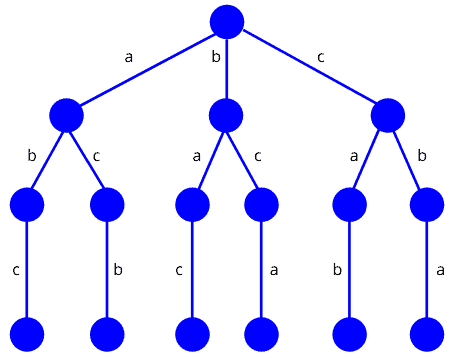1. 概述
在本文中,我们将深入探讨回溯算法的理论基础,并通过一个经典问题来演示其应用。回溯算法虽然效率不高,但在某些特定场景下非常实用,尤其是在没有更优解法时。
2. 回溯算法简介
回溯是一种暴力搜索算法,它通过逐步构建候选解,并在发现当前路径不可能满足条件时“回退”来剪枝,从而减少不必要的计算。
它的核心思想是:
- 使用深度优先搜索(DFS)策略遍历解空间
- 用状态空间树(State-Space Tree)表示所有可能的解
- 每一层代表一个决策点,每一支代表一个变量取值
- 如果当前路径不满足约束条件,就立即回退(backtrack)
✅ 优点:能找出所有满足条件的解
❌ 缺点:时间复杂度高,适用于小规模问题
3. 示例:排列约束问题
我们来看一个简单的例子,理解回溯的执行过程。
问题描述:
给定三个字符 a, b, c,要求生成所有排列,并排除 c 与 a 相邻的情况。
3.1 状态空间树构建
我们首先构建一个状态空间树,每一层代表一个字符的选择:

3.2 所有可能排列
所有排列如下:
- (a,b,c)
- (a,c,b)
- (b,a,c)
- (b,c,a)
- (c,a,b)
- (c,b,a)
3.3 剪枝后有效解
根据约束条件(c 不能与 a 相邻),有效解为:
- ✅ (a,b,c)
- ✅ (c,b,a)
其余排列都被剪枝,最终只保留这两个合法解。
4. 适用场景
回溯算法适用于以下几类问题:
- 决策问题:只要找到一个可行解即可
- 优化问题:寻找最优解(如旅行商问题)
- 枚举问题:找出所有可行解(如数独)
⚠️ 注意:回溯算法不是高效解法,适合对时间要求不高的场景。
5. N皇后问题详解
5.1 问题描述
N皇后问题是回溯算法的经典应用。其定义如下:
在一个
n x n的棋盘上放置n个皇后,使得它们互不攻击(即任意两个皇后不能在同一行、同一列或对角线上)。
5.2 伪代码实现
以下是一个使用回溯的伪代码实现:
algorithm NQueen(Q[n], k)
// Q: 保存皇后位置的数组
// k: 当前处理的行号
if k == n + 1:
return Q // 找到一组解
for j from 1 to n:
valid = true
for i from 1 to k - 1:
if Q[i] == j or Q[i] == j + (k - i) or Q[i] == j - (k - i):
valid = false
break
if valid:
Q[k] = j
NQueen(Q, k + 1) // 递归处理下一行
5.3 Java 实现示例
以下是 Java 实现的一个完整示例:
public class NQueens {
private static int count = 0;
public static void solveNQueens(int n) {
int[] board = new int[n + 1]; // board[1..n]
backtrack(board, 1, n);
System.out.println("Total solutions: " + count);
}
private static void backtrack(int[] board, int row, int n) {
if (row > n) {
printBoard(board);
count++;
return;
}
for (int col = 1; col <= n; col++) {
if (isSafe(board, row, col)) {
board[row] = col;
backtrack(board, row + 1, n);
}
}
}
private static boolean isSafe(int[] board, int row, int col) {
for (int i = 1; i < row; i++) {
int sameCol = board[i] == col;
int sameDiag1 = board[i] - i == col - row;
int sameDiag2 = board[i] + i == col + row;
if (sameCol || sameDiag1 || sameDiag2) {
return false;
}
}
return true;
}
private static void printBoard(int[] board) {
int n = board.length - 1;
for (int i = 1; i <= n; i++) {
for (int j = 1; j <= n; j++) {
System.out.print(board[i] == j ? "Q " : ". ");
}
System.out.println();
}
System.out.println();
}
public static void main(String[] args) {
solveNQueens(5);
}
}
5.4 示例输出(5x5棋盘)
运行以上代码将输出 10 个解,例如:
. Q . . .
. . . Q .
Q . . . .
. . Q . .
. . . . Q
...(其他解略)
Total solutions: 10

5.5 时间复杂度分析
回溯法的最坏时间复杂度为 **O(n!)**,但在 N 皇后问题中,由于剪枝的存在,实际运行时间会大大减少。不过整体复杂度仍较高,约为 **O(2ⁿ)**。
6. 总结
回溯算法是一种暴力搜索 + 剪枝优化的策略,适用于:
- 找出所有可行解
- 没有更优算法可用时
- 对时间不敏感的场景
虽然效率不高,但在某些特定问题中(如 N 皇后、数独、组合问题等),回溯仍是解决问题的有力工具。
✅ 优点:逻辑清晰、通用性强
❌ 缺点:时间复杂度高,不适用于大规模问题
建议在小规模问题中使用,或作为算法设计初期的验证手段。